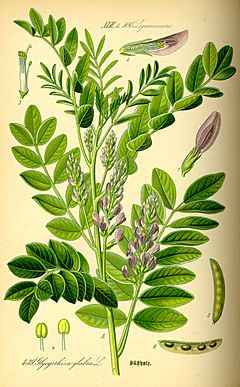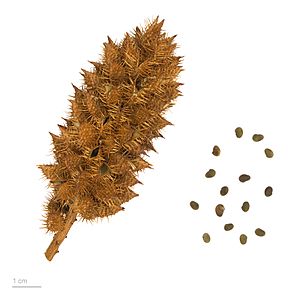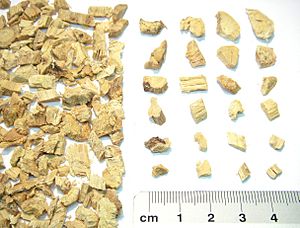Liquorice facts for kids
Quick facts for kids Liquorice |
|
|---|---|
 |
|
| Scientific classification | |
| Kingdom: | |
| Division: | |
| Class: | |
| Order: | |
| Family: | |
| Subfamily: | |
| Tribe: | |
| Genus: | |
| Species: |
G. glabra
|
| Binomial name | |
| Glycyrrhiza glabra |
|
| Synonyms | |
|
|
Liquorice (pronounced LICK-uh-rish) is a sweet flavor. It comes from the root of a plant called Glycyrrhiza glabra. You might also see it spelled "licorice" in some places, like the United States.
This plant is a type of legume, which means it's related to beans and peas. It grows naturally in southern Europe and parts of Asia. The liquorice plant is an herb that lives for many years (perennial). It can grow up to 1 meter (about 3 feet) tall. Its leaves are made up of smaller leaflets, usually 9 to 17 of them, arranged along a stem (pinnate). The flowers are purple to pale blue. They grow in loose bunches (inflorescence) and are about 1 centimeter (half an inch) long. The fruit is a long, flat pod that holds several seeds.
Growing Liquorice
Liquorice plants grow best in sunny places. They like deep valleys with soil that drains water well. Farmers usually harvest the roots in the autumn. This happens two to three years after the plants are put in the ground.
Many countries around the world grow liquorice. These include India, Iran, Italy, Afghanistan, China, Pakistan, Iraq, Azerbaijan, Uzbekistan, Turkmenistan, and Turkey. A company called M&F Worldwide makes most of the liquorice flavors sold globally.
Liquorice as a Sweet Treat
You can find liquorice flavor in many different candies or sweets. Often, other flavors like aniseed oil are added. This means the actual amount of liquorice in these candies can be quite small. Most liquorice candies are bought by people in the European Union.
In the Netherlands, liquorice candy (called drop) is very popular. It comes in many shapes and flavors. People often mix it with mint, menthol, aniseed, or laurel. Mixing it with ammonium chloride (called salmiak) is also common. A popular type of liquorice in the Netherlands is zoute drop, which means "salty liquorice." It doesn't have much regular salt (sodium chloride). Its salty taste comes from ammonium chloride. Strong, salty sweets are also popular in Nordic countries.
Dried sticks of liquorice root were once a traditional candy in the Netherlands. They were sold as zoethout (meaning 'sweet wood'). People would chew on them to release the sweet flavor. This sweetness is 30 to 50 times stronger than regular sugar. It also doesn't harm teeth. However, since the 1970s, zoethout has become less common. People now prefer easier-to-eat candies.
Pontefract in Yorkshire, England, was the first place to mix liquorice with sugar to make sweets. This is how modern liquorice candies began. The famous Pontefract cakes were first made there. In some parts of England, liquorice is sometimes called 'Spanish'. This is because Spanish monks supposedly grew liquorice roots at Rievaulx Abbey.
In Italy (especially in the south), Spain, and France, people enjoy liquorice in its natural form. They simply dig up the root, wash it, dry it, and chew it. It helps to freshen their breath. In Italy, you can also find small, black pieces made from pure liquorice extract. These have a bitter taste. In Calabria, Italy, a popular liqueur is made from pure liquorice extract. Liquorice is also used in Syria and Egypt. There, it's sold as a drink by street vendors and in shops.
Gallery
See also
 In Spanish: Glycyrrhiza glabra para niños
In Spanish: Glycyrrhiza glabra para niños










